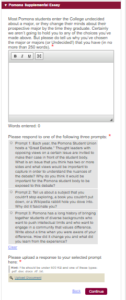The Ultimate Guide to Applying to Pomona
When we consider colleges, we often draw a distinction between small liberal-arts colleges and large universities, both of which educational models have their own particular strengths and weaknesses. However, some colleges seem to meld the best of both worlds, and Pomona College is a great example of this combination. With help from the larger Claremont Colleges consortium, of which it is one of the founding members, Pomona pairs the intimacy and personal attention of a small liberal-arts college with the resources and wide-ranging opportunities of a much larger university, to the great benefit of its student body. Pomona is home to a highly diverse group of undergraduates whose academic interests are as varied as their backgrounds, but who are united in their academic prowess, talent, and open-mindedness. The academic culture at Pomona is one of collaboration and cooperation, and the school claims to be “competitive but not cutthroat— a very important distinction.” Its location in sunny Southern California, within reach of both the mountains and the ocean as well as the big-city energy of Los Angeles, certainly doesn’t hurt its appeal. Are you considering applying to Pomona? Read on for more information about life at Pomona, the Pomona application and admissions process, and what you can expect if you put Pomona on your college list. Introducing Pomona Located in the suburban setting of Claremont, California, only about 35 miles away from Los Angeles, Pomona College is a very well-regarded private liberal arts college. According to the U.S. News and World Reports rankings, Pomona is tied for fourth place in the National Liberal Arts Colleges category, and is also highly ranked for its undergraduate teaching and for being a great value financially. About 1,650 undergraduate students attend Pomona, with 98% of these students residing on the 140-acre campus. Students can choose between 48 different academic majors for their Bachelor of Arts degrees. The most popular majors are mathematics, economics, and majors in the biological sciences. Academic minors are available in many of the same fields. Pomona is the oldest member of the Claremont Colleges, sometimes formally known as the Claremont University Consortium, a consortium of seven schools (five undergraduate and two graduate) with a total enrollment of around 8,000 students. There’s something for everyone among the Claremont colleges, including a women’s-only school, five undergraduate schools, two graduate institutions, and a variety of different emphases among the different schools involved. For Pomona students, the presence of these other institutions makes for a uniquely enriched college experience. Students enrolled at Pomona can take up to 50% of their courses at the other undergraduate institutions in the Claremont consortium, and most students do take advantage of this access to over 2,200 courses in total. The Claremont Colleges also share facilities such as dining halls and libraries, expanding the social world for Pomona students beyond their own relatively small college. In addition to its connections with the other Claremont Colleges, Pomona also participates in dual-degree undergraduate pre-engineering programs which allow students to split their time between Pomona and either the California Institute of Technology, Dartmouth College, or Washington University in St. Louis. Students will not need to apply to these engineering programs until after they have matriculated at Pomona and consulted with a Pomona advisor, but interested applicants should be aware that they will need to plan out their courses carefully from the beginning in order to make sure all requirements are met. As we mentioned, social and extracurricular life at Pomona involves a great deal of overlap with the other Claremont Colleges. In conjunction with Pitzer College, one of the other Claremont Colleges, Pomona offers opportunities to play on 21 varsity athletic teams. Intramural and club sports are also popular. The consortium as a group offers more than 250 student groups, some school-specific, others which bring together students from the various Claremont schools. Many students enjoy participating in outdoor activities in the greater Southern California landscape. One much-beloved Pomona tradition, the annual “Ski-Beach Day,” involves a ski trip in the morning and a beach trip that very afternoon, all within a reasonable drive’s distance of Pomona’s campus. Pomona Admissions Information Admission to Pomona is very competitive. Pomona received 8,104 applications for the class of 2020, and 743 applicants were accepted, making the acceptance rate 9.1%. The applicant pool is typically extremely strong, and Pomona is not able to make admission offers to all qualified students who apply. When reviewing applications, Pomona’s admissions office takes into account a variety of factors. Along with “academic aptitude” in the form of grades and test scores, Pomona is looking for students who have taken full advantage of the academic challenges offered to them at their particular schools. In other words, you won’t be penalized if your high school didn’t offer the best courses or other opportunities; Pomona is more interested in what you accomplished with the materials to which you did have access. The college looks for essays that show “passion” and “thoughtfulness”, teacher and counselor recommendations that indicate you will be a positive contributor to the community, and such qualities as openness to new ideas, adventurousness, and personal character. Pomona also appreciates applicants who have had some involvement with the creative arts, including music, theater, dance, or visual art. In addition to first-year applicants, Pomona also accepts applications from transfer applicants who have completed one year or more of college elsewhere, though the transfer admissions process is also extremely competitive. For the 2015-2016 school year, Pomona received 356 transfer applications and admitted 20 transfer students. This makes the transfer admission rate about 5.62%. Paying for Pomona For the 2016-2017 school year, the billed cost of attendance for a Pomona student is $64,957, which includes $49,005 for the year’s tuition. This billed cost does not include the cost of books, personal expenses, travel to and from Pomona, or certain fees for optional activities, which will vary from student to student. For applicants from the United States, admission to Pomona is need-blind. This means that, for these applicants, their ability to pay for college will not impact whether or not they are admitted. 57% of students at Pomona receive need-based financial aid from the college to assist with the cost of their education. While Pomona’s own institutional financial aid is entirely need-based, students can bring in additional funds from outside merit scholarships to cover their own financial obligation to the college. Students are not required to take out loans as part of their financial aid packages, though supplemental loans are available as a financing option, and students are also expected to contribute to their education from their own income. All students who wish to apply for financial aid must submit the CSS Profile and tax documents for their families; students who are U.S. citizens or permanent residents must also submit the FAFSA. The CSS Profile is due on November 1st for Early Decision 1 students, February 1st for Early Decision 2 students, and March 1st for Regular Decision or Transfer students. (We’ll go over what these categories mean later on in this post.) Applicants on all timelines must submit the FAFSA and tax documents by March 1st. Pomona’s need-based financial aid policy means that the college assesses the data it collects through the financial aid application documents, determines the amount of financial need for each student who applies, and creates a grant-based financial-aid package intended to bridge the gap between what the student’s family can pay and the full cost of attending Pomona. Applicants from the United States can visit Pomona’s Net Price Calculator to get an idea of how much aid they might receive if accepted, though this estimate is not binding. The situation is somewhat different for applicants from outside the United States. At Pomona, admission for international applicants is need-aware, which means that the ability of these applicants to pay for college may impact their admissions decisions. International applicants who wish to apply for financial aid must do so when they submit their admissions applications. No financial aid is available for international transfer students. International applicants who wish to apply for financial aid will need to submit the CSS Profile and the International Student Certification of Finances form, along with a translated copy of their family’s most recent tax documents or other statements of earnings. Applicants from certain countries (listed on Pomona’s website) will be able to submit the International Student Financial Aid Application in place of the CSS Profile. All financial aid application materials for international students must be submitted by March 1st. Students who are undocumented residents of the United States are not considered to be international applicants at Pomona, unlike at some schools, and therefore the need-aware policy does not apply to them. More information on Pomona’s approach to admission and financial aid for undocumented students or students with DACA status can be found on the Pomona admissions website. The Pomona Application Pomona offers its prospective first-year students three avenues to applying: the Common Application, the Coalition Application, and the Questbridge application. You can choose whichever of these application options suits you best; which application you use has no bearing on your admission decision. Using the Common App or the Coalition App, prospective applicants can choose between three different timelines on which to apply to Pomona: Early Decision 1 (ED I or ED 1), Early Decision 2 (ED II or ED 2), or Regular Decision (RD). The ED 1 and ED 2 programs are both binding Early Decision programs, which means that students who apply to Pomona on these timelines cannot apply to any other schools using that same timeline, and also sign an agreement obligating them to attend Pomona if they are accepted. ED 1 students must submit their applications by November 15th, and will receive their admissions decisions by December 15th. ED 2 students must submit their applications by January 18th, and will receive their admissions decision by February 15th. RD applicants also submit their applications by January 1st, but don’t receive their admissions decisions until April 1st. You can visit the Pomona admissions website for additional information on application requirements and timelines. Students who apply to Pomona through the QuestBridge National College Match program have an initial Pomona application deadline of November 1st. In order to make use of the QuestBridge application process for Pomona, however, a prospective applicant must have already applied separately to the QuestBridge program and been named a Finalist in that program. We’ll go over more information about the QuestBridge program below. Finally, as we mentioned above, Pomona also accepts applications from students seeking to transfer to Pomona from other colleges. The due date for all transfer applications, which are submitted using the Common App, is February 1st, and applicants will receive their admissions decisions by April 1st. You can learn more about Pomona’s transfer policies by visiting their web page for transfer applicants. Common Application In order to apply to Pomona through the Common App, you’ll first need to create a Common App profile online and add Pomona to your My Colleges list. Then, you’ll need to complete the basic questions that the Common App asks of everyone. For instructions on how to approach the Common App, take a look at our User’s Guide to the Common App, as well as our targeted posts on how to fill out the sections about your demographics, citizenship, academics, activities, awards, and more. Once you’ve completed the main Common App questions, you’ll need to answer the questions contained in the Pomona-specific Common App supplement. To get to this supplement, navigate to your My Colleges tab and click on Pomona. On the left side, under Pomona’s tab and the heading that says Application, click on the word Questions. You’ll see the following screen: Here, you’ll see five tabs, labeled General, Academics, Contacts, Family, and Pomona Supplemental Essay. Below, we’ll go over the questions contained in each of these categories in greater detail. For the General section, you’ll answer the following questions: For the Academics section, you’ll answer the following questions: For the Contacts section, you’ll answer the following questions: For the Family section, you’ll answer the following questions: Finally, you’ll need to answer the questions in the Pomona Supplemental Essay section, which you can see below: For the first question, all applicants will answer the same prompt in a text box within the application: “Most Pomona students enter the College undecided about a major, or they change their minds about their prospective major by the time they graduate. Certainly we aren’t going to hold you to any of the choices you’ve made above. But please do tell us why you’ve chosen the major or majors (or Undecided!) that you have (in no more than 250 words).” For the second question, you will choose between three different prompts and upload a document containing your written response: “Please respond to one of the following three prompts: For a detailed breakdown of how to write these essay responses, see our CollegeVine blog post How to Write Pomona College’s Essays 2016-2017. Coalition Application The Coalition App is another application system available for you to use when applying to Pomona, as well as the other Coalition App member schools. Created by the Coalition for Access, Affordability, and Success, the Coalition App is available for the first time for the 2016-2017 application season. The Coalition App system asks for much of the same basic information as the Common App, albeit in somewhat different ways. However, the Coalition App’s differences may make it a more appealing option for you personally. If you’re considering applying to a school that offers the Coalition App option, it’s a good idea to look at the Coalition App website to see how its approach to gathering admissions information is different. As with the Common App, in order to explore and apply using the Coalition App, you’ll need to create a Coalition App account online. Once your account is created, you can set up your profile, fill out your basic information, and add Pomona to your list of schools. The Coalition App has its own set of basic essay prompts that are presented to all applicants. For a detailed description of how to respond to each Coalition App essay prompt, you can take a look at the CollegeVine blog post on How to Write the Coalition Application Essays 2016-17. In addition to the basic Coalition App, you’ll need to fill out some supplemental questions that are Pomona-specific. You can find these supplemental questions on the Coalition App website itself, or on Pomona’s own website. Pomona’s supplemental questions for 2016-2017 are as follows: “Who Environments and experiences shape people in different ways. What is your world like? As a result, what characteristics, beliefs, or values will you bring with you when you begin college, and how does this help us understand who you are? You can respond to this prompt with an essay of at least 400 words, a collection of photos, a video response (up to 90 seconds long), or something else from your Locker. If you choose to submit a collection of photos or if your video response does not include narration, please also include a short statement telling us what you hope we will learn from your submission. How Please respond to one of the following three prompts with a written response of at least 400 words. As you can see, the Who question above can be answered either in a relatively traditional way, or in a more creative and unusual way. Your options here are very broad, which can be either freeing or overwhelming. There’s no shaming in choosing to write a relatively standard essay if you feel that your writing skills are strong. If you do choose to take the more creative route in answering this question, you’ll need to carefully consider what kind of submission will allow you to accurately represent yourself as a student and cast yourself in the best possible light. As a substitute for an essay, your response should take as much as or even more preparation than an essay. Just as you might have a tutor or teacher review your college essays before you submit them, if you’re submitting a creative response, it may be wise to ask a teacher or mentor to help you prepare this response. The How question, on the other hand, provides a more straightforward choice of prompts. You might be able to tweak an essay you’re writing for another one of your college choices to fit this question, or to modify your essay based on this prompt for another school. For more advice on how to write your college application essays, check out the CollegeVine blog. In addition to the Common App and the Coalition App, certain students can apply to Pomona through the QuestBridge organization. QuestBridge is designed to assist students from low-income backgrounds navigate the college application process and gain equal access to some of the best colleges in the United States. In order to apply to Pomona through QuestBridge, prospective students must first be eligible for the QuestBridge National College Match program, go through the application process for that program, and be named a Finalist. They will then have the assistance of the QuestBridge organization and its mentors in preparing their college applications. For 2016, the deadline to apply to QuestBridge itself is September 27th, and students named Finalists will submit their applications to Pomona by November 1st. Interested students can learn more about the QuestBridge National College Match program, who is eligible, and how to apply on the QuestBridge website. You can read more about Pomona’s relationship with QuestBridge on the Pomona admissions website. Interviewing for Pomona Interviews, whether on-campus or off-campus, are highly recommended as part of the application process for all students applying to Pomona. These interviews are carried out by admissions officers and senior interviewers if on-campus, or alumni interviewers if off-campus. While not strictly required, the interview process allows Pomona to get to know you beyond what’s printed on your application. If you’re able to visit Pomona’s campus, you’re welcome to register for an on-campus interview. In order to get an on-campus interview, you’ll need to register online on Pomona’s interview portal at least three weeks prior to your visit. You can also attend information sessions and tours while you’re there. Check out the Pomona website for the relevant deadlines for each admissions timeline. If you’re not able to visit campus, you can request an off-campus interview, conducted in the area where you live by a Pomona alum and arranged for a time and place that are convenient for you. To request an interview, you’ll need to use Pomona’s online system for scheduling alumni interviews, which will open in September of 2016. For international applicants who are not currently attending high school in the United States, the interview options are slightly different. Applicants who are planning to visit Pomona can certainly schedule on-campus interviews. Some international applicants may be be able to interview with Pomona alumni in their own areas of residence; these applicants will need to register using the alumni interview scheduling system, just as domestic students do. However, there are many areas of the world where Pomona interviewers are not available. In these situations, Pomona recommends that applicants schedule an interview with a third-party interviewing service, such as InitialView or CIEE. Fees are associated with these services, but Pomona is able to provide fee waivers if necessary. Since these third-party interviewers are not employed by Pomona, they will not be able to answer specific questions you might have about Pomona, but they will be able to report back to the college with a more personal perspective on your qualifications. For more advice about how to prepare for your college interviews, what to expect, and some dos and don’ts, check out the CollegeVine blog. Pomona Application Requirements In addition to the Common App or Coalition App and its Pomona supplement, you’ll need to submit the following documents to be considered for admission: In addition, applicants who wish to apply for financial aid must submit their financial-aid applications by the appropriate deadlines. Students who apply through the QuestBridge program may have slightly different application procedures, and are encouraged to follow any instructions they receive from QuestBridge. Hearing Back from Pomona Pomona applicants using the ED 1 and ED 2 timelines will receive their admissions decisions by December 15th and February 15th, respectively. At this point, they’ll either be accepted, rejected, or deferred to the RD admissions round. Since both of the ED timeline options are binding, applicants who are accepted under either of the ED timelines have already agreed to attend Pomona, and need only to confirm their attendance and submit their enrollment deposits. Applicants who are deferred under one of the ED timelines will be reconsidered with the pool of RD applicants. We’ll go over more about what deferral means for you below. If you are rejected from Pomona in the ED 1 or ED 2 rounds, you may not reapply during the same application cycle. For example, if you were rejected in the ED 1 round, you would be not be allowed to apply in the ED 2 or RD rounds. You may still have a chance to attend Pomona in the future, however, through the transfer application process. Applicants under the RD timeline, along with any applicants who were deferred under either of the ED timelines, will receive their admissions decisions by April 1st. At this time, you may be accepted, rejected, or waitlisted. (We’ll go over what being waitlisted means for you below.) Applicants who are accepted to Pomona will need to make their college decision and inform Pomona of whether they intend to enroll by May 1st. If you’re accepted to Pomona, whether in the ED 1, ED 2, or RD round, you’ll need to submit a $500 enrollment fee in order to confirm your place in the matriculating class. If paying this fee would represent a hardship for your family, the admissions office may be able to arrange for a payment plan or a reduced fee. You’ll receive more information with your acceptance letter. Deferrals and the Waitlist at Wellesley Applicants to Pomona who use either of the ED application timelines should be prepared for the possibility that they may be deferred. Deferred students are neither rejected nor accepted when ED offers of admission are made; rather, the admissions office elects to reconsider their applications later, with the larger pool of RD applications. Note that deferred ED 1 applicants will be deferred all the way to the RD round, not simply to the ED 2 round. If you’re deferred from Pomona, either through the ED 1 process or the ED 2 process, you’re by no means out of the running for admission. Once you receive notification that you’ve been deferred, you’re welcome to write to the admissions office and reiterate your strong interest in attending Pomona. You can and should include evidence of any ways in which you’ve strengthened your profile as an applicant since you submitted your initial application, including higher grades, higher test scores, or new awards or honors you’ve received. When RD admission decisions are released, some students are waitlisted, meaning that they are placed on a list of students who may be considered for admission, depending upon how many spaces become available in the matriculating class. If you’re waitlisted at Pomona, you can decide whether or not you would like to fill out a form to remain on the waitlist and be considered for potential future openings. As with deferred students, if you’re waitlisted at Pomona, it’s a good idea to write to your admissions officer and confirm that you are still interested in attending Pomona if accepted. You can include a brief update about any new achievements or other items you’d like to share, but at this point, you shouldn’t submit any lengthy new documents. If you’re selected for admission off the waitlist, you’ll be notified in early to mid-May. For the class of 2020, Pomona ended up accepting 38 students from the waitlist, resulting in a waitlist acceptance rate of about 8%. Since the acceptance rate for waitlisted students is this low, you should definitely make plans to attend another college while waiting to hear back from Pomona, including submitting an enrollment deposit if necessary. If you’re accepted to Pomona off the waitlist, you’ll be able to “unenroll” at the other college, and Pomona reassures students that this is “a standard and accepted part of the admissions process” for those other schools. Does Pomona sound like a great place for you to flourish as a college student? You can learn more about the school’s history, its programs, and life on campus by visiting Pomona’s website. Also, check out the website for the Claremont Colleges, where you can dig deeper into the opportunities and resources that this unique educational community offers. Curious about your chances of acceptance to Pomona? Our free chancing engine takes into account your GPA, test scores, extracurriculars, and other data to predict your odds of acceptance at over 500 colleges across the U.S. We’ll also let you know how you stack up against other applicants and how you can improve your profile. Sign up for your free CollegeVine account today to get started!
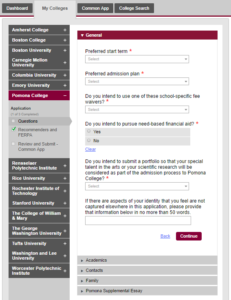
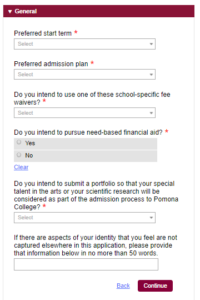
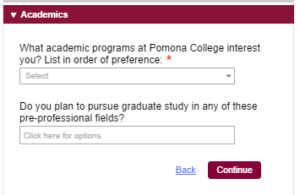
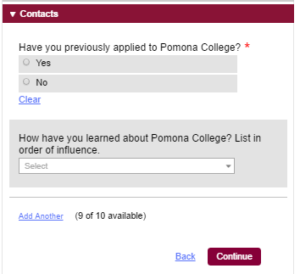
QuestBridge Application



